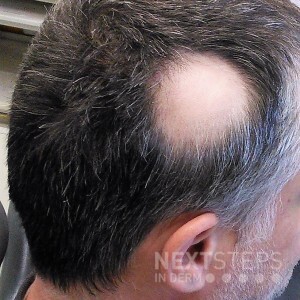Hair Loss- Friday Pop Quiz
 A 36-year-old male presents to the dermatology clinic with the findings depicted in this image. He states that this is the only involved area, and he denies any other associated symptoms. Two 4-mm punch biopsies are performed, one from the affected area and one from the unaffected region. Which of the following histopathologic findings are most likely associated with in this condition?
A. D …
A 36-year-old male presents to the dermatology clinic with the findings depicted in this image. He states that this is the only involved area, and he denies any other associated symptoms. Two 4-mm punch biopsies are performed, one from the affected area and one from the unaffected region. Which of the following histopathologic findings are most likely associated with in this condition?
A. D …
 A 36-year-old male presents to the dermatology clinic with the findings depicted in this image. He states that this is the only involved area, and he denies any other associated symptoms. Two 4-mm punch biopsies are performed, one from the affected area and one from the unaffected region. Which of the following histopathologic findings are most likely associated with in this condition?
A. D …
A 36-year-old male presents to the dermatology clinic with the findings depicted in this image. He states that this is the only involved area, and he denies any other associated symptoms. Two 4-mm punch biopsies are performed, one from the affected area and one from the unaffected region. Which of the following histopathologic findings are most likely associated with in this condition?
A. D … 

 Dermatology needs to re-think the use of gendered language in aesthetics, according to a brief communication published in the January issue of the Journal of Drugs in Dermatology. The authors contend that gendered language can cause upset or offense in patients with nonbinary gender identity or gender dysphoria, and that gender-neutral language can help dermatologists provide better and more consi …
Dermatology needs to re-think the use of gendered language in aesthetics, according to a brief communication published in the January issue of the Journal of Drugs in Dermatology. The authors contend that gendered language can cause upset or offense in patients with nonbinary gender identity or gender dysphoria, and that gender-neutral language can help dermatologists provide better and more consi …  Next Steps in Derm, in partnership with ODAC Dermatology, Aesthetic and Surgical Conference, interviewed Dr. Vishal A. Patel, (fellowship trained Mohs micrographic surgeon who serves as Director of Cutaneous Oncology at the GW Cancer Center and Director of Dermatologic Surgery at the GW Department of Dermatology) about how Artificial Intelligence (AI) can help clinicians. Watch as he discusses A …
Next Steps in Derm, in partnership with ODAC Dermatology, Aesthetic and Surgical Conference, interviewed Dr. Vishal A. Patel, (fellowship trained Mohs micrographic surgeon who serves as Director of Cutaneous Oncology at the GW Cancer Center and Director of Dermatologic Surgery at the GW Department of Dermatology) about how Artificial Intelligence (AI) can help clinicians. Watch as he discusses A …  This month’s Patient Buzz includes articles about the latest minimally invasive cosmetic treatments, or as the Hollywood Reporter calls it, “The new ‘slow’ plastic surgery.” From diamond microdermabrasion to Aquagold for microinfusions to stem cell face lifts, your patients are reading about a lot of different cosmetic treatments in the consumer press.
Be prepared for your patients’ …
This month’s Patient Buzz includes articles about the latest minimally invasive cosmetic treatments, or as the Hollywood Reporter calls it, “The new ‘slow’ plastic surgery.” From diamond microdermabrasion to Aquagold for microinfusions to stem cell face lifts, your patients are reading about a lot of different cosmetic treatments in the consumer press.
Be prepared for your patients’ …  Hypopigmented mycosis fungoides (HMF) is a rare variant of cutaneous T-cell lymphoma (CTCL) that often manifests in younger patients with darker skin types in a centripetal distribution.¹ Average age of diagnosis is often 14 years.² The diagnosis is often missed due to its low incidence and lack of clinical suspicion. Misdiagnosis and failure to obtain biopsies lead to a long latency period fr …
Hypopigmented mycosis fungoides (HMF) is a rare variant of cutaneous T-cell lymphoma (CTCL) that often manifests in younger patients with darker skin types in a centripetal distribution.¹ Average age of diagnosis is often 14 years.² The diagnosis is often missed due to its low incidence and lack of clinical suspicion. Misdiagnosis and failure to obtain biopsies lead to a long latency period fr …